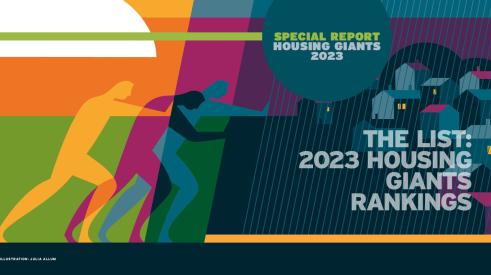|
A good rule of thumb during a housing downturn, when you have more entry-level home buyers than luxury home buyers, is to reduce the cost of the house in every way you can. You are generally better off targeting buyers who already own a home.
Entry-Level Buyers are Tapped OutFalling interest rates and aggressive lending practices have helped first-time buyers more than any other group. Accordingly, the homeownership rates among younger buyers reached all-time highs in 2005.
 |
Homeownership rates among the under-25 demographic increased from 15 percent in 1994 to 25 percent in 2004. In the same time, the homeownership rate increased from 42 percent to 49 percent among the 25–34 year-old demographic. The impact of these two groups alone accounted for approximately 1.3 million additional owned homes over the last 10 years.
Based on the statistics, we advocate builders target older buyers.
Future Move-Ups and Move-DownsMove-down buyers are a great opportunity for home builders. Census data shows a steady preference for homeownership for the older generations — a rate that even increases past the age of 65. This becomes particularly important as the first of the baby boomers begin to approach retirement age.
Homeownership rates are highest for the demographic over the age of 55. Approximately 81 percent of households over the age of 65 currently own their home, a rate that has steadily increased over the last 25 years.
Significant home equity means move-up buyers don't have an affordability problem. Although they generally have little urgency to move, they usually have the financial means to do so.
In today's market, building a quality move-up home in a highly desirable area has a much higher chance of success today than building entry-level homes in remote locations.
The History of HomeownershipAs mortgage rates soared to all-time highs in the early '80s, the national homeownership rate dropped. Home ownership slipped out of the reach of many potential buyers, most notably the younger buyers. From the mid-1980s until 1994, this measure remained flat, hovering around 64 percent. However, homeownership from 1995–2004 witnessed tremendous growth, peaking at 69 percent by 2004. While rates increased across all age groups during these 10 years, the younger buyers experienced the greatest acceleration in buying activity.
Chris Porter of John Burns Real Estate Consulting contributed to this report.
John Burns helps many of the largest companies in the industry with strategy and monitoring market conditions. He can be reached at jburns@realestateconsulting.com.
| EMPLOYMENT | AFFORDABILITY | PERMITS | ||||||||||
| Short-Term Outlook/Grade | 1-Year Payroll Employment Growth | 1-Year Growth Rate | Unemployment Rate | Median Resale Home Price | Resale Housing Costs as % of Income* | Housing Cycle Barometer** | 12-Month Single-Family Permits | 1-Year Single-Family Growth | 12-Month Total Permits | Total Permits as % of Peak Permits*** | ||
| 1 | Houston | 81,100 | 3.4% | 4.1% | 151,400 | 26% | 5.2 | 53,729 | 2% | 71,247 | 95% | |
| 2 | Atlanta | 41,600 | 1.7% | 3.9% | 169,813 | 24% | 2.8 | 48,914 | -21% | 62,764 | 84% | |
| 3 | Phoenix | 78,800 | 4.2% | 3.4% | 265,000 | 40% | 6.6 | 36,174 | -37% | 45,459 | 66% | |
| 4 | Riverside-San Bernardino | 43,600 | 3.4% | 4.9% | 395,000 | 65% | 9.3 | 29,192 | -36% | 33,504 | 58% | |
| 5 | Dallas | 74,600 | 3.7% | 4.1% | 161,200 | 27% | 5.0 | 25,311 | -22% | 34,650 | 47% | |
| 6 | Orlando | 31,300 | 2.9% | 3.1% | 249,250 | 41% | 7.1 | 20,244 | -25% | 28,211 | 78% | |
| 7 | Chicago | 36,200 | 1.0% | 4.2% | 245,000 | 37% | 5.4 | 20,077 | -32% | 37,626 | 80% | |
| 8 | Charlotte | 22,500 | 2.8% | 4.4% | 159,750 | 25% | 1.3 | 19,637 | -2% | 24,653 | 98% | |
| 9 | Las Vegas | 29,600 | 3.3% | 4.2% | 305,000 | 49% | 7.2 | 17,977 | -43% | 26,101 | 60% | |
| 10 | Austin | 30,900 | 4.3% | 3.5% | 177,100 | 31% | 5.1 | 15,651 | -18% | 23,174 | 87% | |
| 11 | Washington, D.C. | 38,300 | 1.6% | 3.0% | 408,367 | 48% | 8.7 | 14,930 | -32% | 21,388 | 56% | |
| 12 | Tampa | 15,900 | 1.2% | 3.3% | 193,500 | 35% | 6.2 | 14,299 | -48% | 18,671 | 49% | |
| 13 | Fort Worth | 16,900 | 2.0% | 4.2% | 111,500 | 20% | 4.6 | 13,750 | -26% | 18,463 | 48% | |
| 14 | Nashville | 10,600 | 1.4% | 4.0% | 149,000 | 26% | 3.8 | 13,411 | -6% | 14,978 | 82% | |
| 15 | Raleigh-Cary | 16,400 | 3.5% | 3.4% | 188,000 | 28% | 2.7 | 13,272 | -7% | 17,006 | 96% | |
| 16 | San Antonio | 20,200 | 2.5% | 4.0% | 146,900 | 29% | 5.3 | 12,630 | -19% | 17,284 | 74% | |
| 17 | Denver | 19,100 | 1.6% | 4.1% | 234,000 | 37% | 5.5 | 11,206 | -36% | 16,388 | 57% | |
| 18 | Fort Myers | 10,200 | 4.4% | 3.2% | 267,200 | 45% | 6.8 | 11,042 | -50% | 13,774 | 47% | |
| 19 | Minneapolis | 11,900 | 0.7% | 4.4% | 229,000 | 32% | 5.9 | 10,715 | -37% | 14,399 | 51% | |
| 20 | Seattle | 43,600 | 3.1% | 4.4% | 405,000 | 57% | 9.5 | 10,237 | -19% | 21,779 | 79% | |
| Sources: Bureau of Labor Statistics; Census Bureau through the month ending March 2007; John Burns Real Estate Consulting. Data on all markets available at www.realestateconsulting.com **Proprietary affordability scale with 0 meaning most affordable time since 1983, 5 meaning median affordability, and 10 meaning least affordable time. *Annual Mortgage Costs +1/7th of the downpayment divided by income. *** Peak activity since 1985. |
||||||||||||
|
Advertisement
Related Stories
Housing Giants
The 2024 Housing Giants Survey Is Now Open!
Complete the 2024 Housing Giants Survey to see if your company makes the cut in Pro Builder's rankings of the largest home building companies in the country
Housing Giants
Builder Rankings by Revenue: 2023 Housing Giants List
Pro Builder's annual Housing Giants rankings list provides a snapshot in time of builders’ perceived opportunities and challenges. These are the top 240 home builders in the nation, ranked by revenue
Housing Giants
Holding Back the Headwinds
Stormy market conditions strained the nation’s largest home builders in 2022, and they’re bracing for more uncertainty






